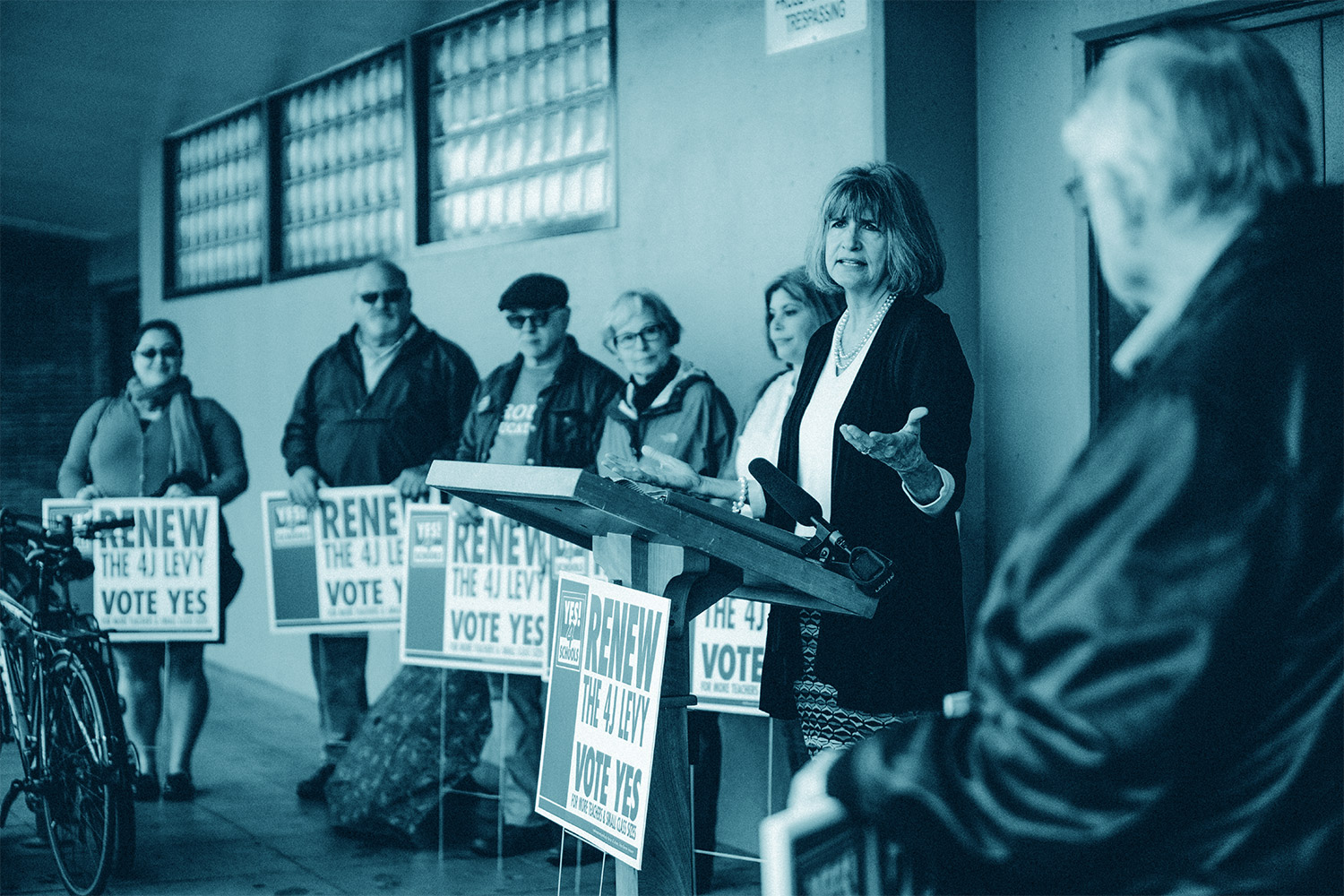On a gray, drizzly day a few days before this month’s torrential downpour, about 10 supporters of Eugene School District 4J addressed a handful of local media outlets during a press conference promoting the local option levy at South Eugene High School.
Last year, on a warm, sunny day at North Eugene High School, 4J asked voters to support a $319.3 million bond that would, among other things, build a new high school for North Eugene. Voters passed the bond measure in the November election.
But don’t confuse the two asks. The bond will be used for improving facilities and imposed a new property tax. The levy supports staff, and that tax has been in effect since 2000.
The levy, also known as Measure 20-301, is a way for the community to signal its support of the school districts as state funding of education continues to decline. The levy, which equals 9 percent of the 4J general fund budget, provides $17 million per year to Eugene’s school district. If supporters don’t OK it, the levy would expire in 2020 and would spell disaster for the school district.
Enlarge

Todd Cooper
What ‘No’ Looks Like
November 2014 was the last time the 4J levy was on the ballot, and it won overwhelmingly: 75 percent of voters supported it. You could assume that the levy would pass in 2019. However, as the 2016 election has indicated, political wisdom can’t predict the future.
Sure, not renewing the levy could save a few bucks. Since it’s not an increase, the levy would continue to cost property owners $1.50 per $1,000 of assessed value.
If the levy weren’t to be renewed by Eugene voters, it could be tragic for local education. The school district could experience an increase in class sizes due to layoffs.
“We’d be looking at significant layoffs in this district,” says Tad Shannon, Eugene Education Association president. “It would be a disaster.”
The district would have to chop about 9 percent from the budget, which is about 161 teachers, says 4J board member and former Eugene mayor Jim Torrey. If the levy isn’t renewed, though, it doesn’t necessarily mean that all of those teachers would lose their jobs.
“You’re going to have counselors, educational assistants, mental health staff that are going to be impacted,” Torrey says. “We would end up cutting some areas of administrative.”
Cutting 9 percent would look like 10 years ago when 4J cut $22 million out of the district’s budget, he adds.
“We closed schools, we merged schools,” he says.
4J board member and campaign co-chair Anne Marie Levis says she doesn’t know what she’d do if it doesn’t pass.
“I never plan for the worst,” she says. “If we have to, we could put it on the ballot in November. But I believe in the Eugene voters and I believe in them investing in schools.”
Enlarge

Todd Cooper
Desperate Measures
At first, it might make sense to harbor some resentment at 4J for asking to continue the levy after asking voters to increase property taxes in November 2018. A levy and a bond, though, are two different methods of raising money.
The bond was necessary for the district to build a new North Eugene High School, for example. But the school district can’t use any of that money on staff.
“This represents bodies,” Shannon says of the levy. “This is for the people in the classroom. We have very high ratios for nurses to students. Like, one to almost 2,000 — almost double the recommended ratio.”
He adds that although voters overwhelmingly supported the bond measure in 2018, renewing the levy is necessary to staff a new North Eugene High School. And, not to discount the importance of new school buildings in the district, if Shannon had to choose either the bond or the levy, he’d choose the latter.
The use of a levy is a revenue tool for school districts in Oregon ever since Measure 5 changed everything in 1990. Measure 5 imposed limits on local property taxes, and control of school funding shifted from the local to the state level.
However, there just wasn’t enough revenue to pay for the state’s education system, says former 4J board member Craig Smith.
The cap on property tax can be compared to California’s Proposition 13 — a useful benchmark for those many Californian transplants living in Eugene — that passed there in 1978. But there’s a difference between the two.
“Ours is worse,” Smith says.
Jenny Ulum, co-chair of the 4J local levy campaign, was working in the Legislature around the time when Prop 13 passed and was aware of sentiment that Oregon would pass something similar to Prop. 13. Legislators developed the Oregon tax rebate, also called the kicker, to try and “ward off” any attempts of mirroring Prop. 13.
“That worked for 10 years,” she says. “Now we have the kicker and Measure 5.”
Ulum wishes Measure 5 would have been sent back to the voters with the amendment that the state would no longer return the kicker refund.
Measure 5, in so many ways, Levis says, decimated public education in Oregon.
The Quality Education Commission, established by the Legislature in 2001 to determine the amount of funding schools need in Oregon, said in its most recent report in 2018 that inflation-adjusted funding per student fell after Measure 5.
Current funding per student is about 8 percent lower than it was after Measure 5 passed in 1990. The report continues that the state is about 9 percent below the national average in education funding. The amount of education funding has declined since 1990, before measures 5 and 50 (latter of which passed in 1997).
Besides capping property taxes, Measure 5 was meant to spread the wealth evenly among school districts. That hasn’t happened. And Oregon schools no longer have a reputation that can attract people to move to the state, Shannon says.
“If you talk to the medical practices, they can’t attract people here,” he says about the image of Oregon’s public education system. “Oregon used to have a reputation of being an innovator and being a desirable place to be. Because of these shackles we found ourselves in because Measure 5 and other things, we’re getting a reputation that’s not a desirable reputation to have as a state.”
He adds that if the public education and higher education system continue to decline, potential employers and future industries might not want to invest in the state.
Enlarge

Todd Cooper
A Multiplier Opportunity
The Oregon Legislature disappointed a lot of people with its proposed budget. Yet there’s a slight glimmer of hope in Salem right now as legislators debate a $2 billion biennial injection in Oregon’s K-12 system, called the Student Success Act.
This revenue package could make the levy more effective for 4J. Levy supporters aren’t banking on the timeliness of the revenue package because of the hurdles it faces. They don’t want voters to think it can replace the levy.
Co-chairs of the Joint Committee on Student Success, state Rep. Barbara Smith Warner of Portland and state Sen. Arnie Roblan of Coos Bay, announced an act on April 4 that would offer much-needed support to Oregon’s schools.
Roblan called it a result of a bipartisan effort after the co-chairs visited more than 77 schools in Oregon.
“The Student Success Act will finally begin fulfilling the promises we’ve made to the next generation. By investing in schools, we can finally give Oregon kids the education they deserve,” he said in a statement.
Even though Oregon educators are still planning a walkout on Wednesday, May 8, to protest a lack of financial support, the Oregon Education Association called the revenue package an “exciting and momentous step” in funding the state’s schools. John Larson, the union’s president, said it addresses the issues that Oregon’s schools face, according to a press release on April 5.
For 4J, it means the levy could have more impact in improving local education.
“This could be a really good time for us to pass this and also have some state reform,” Levis says. “It would be the first time we’d be able to say, ‘We can start dreaming again and start looking at some of these systematic problems we really have to invest in.’”
Shannon agrees.
“It would indicate the first time since Measure 5 passed from my perspective that we are moving in the right direction to restore what we have lost over the past 30 years,” he says. “It would bring us closer to what we call the Quality Education Model.”
The Quality Education Commission, in its 2018 report, found that Oregon spends nearly $2 billion per biennium less than what is needed to have well-funded schools.
The fate of that $2 billion revenue package still has to go through the legislative process and get Gov. Kate Brown’s signature. On April 12, she called for a cut in educator salaries to address ballooning PERS costs. Of course, there’s still another hurdle the Student Success Act could face.
“I’m sure it’ll be referred, so we will have an election,” Shannon says.
Torrey says that process could take a long time. Either the Legislature or voters could refer the revenue package to an election. Because of the lengthy process, it could take another two years for the money to reach schools.
“Even if it were this November, which would be awfully quick to turn around a campaign,” he says. “You’re not going to kick out dollars to a school district in the next year.”
